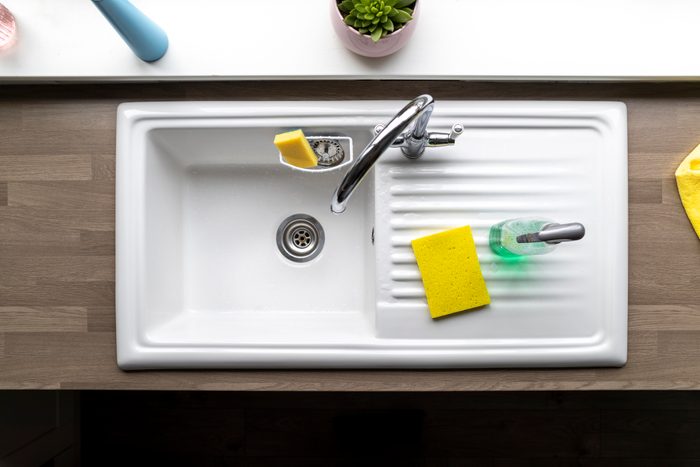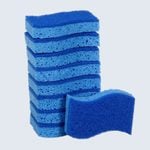How to Clean Your Kitchen Sponge

Keep your kitchen sponges free of bacteria with these three easy cleaning tips.
Our editors and experts handpick every product we feature. We may earn a commission from your purchases.
You likely already have an idea that kitchen sponges can get seriously germy. You use it to clean your dishes, utensils, and cookware—but do you give a thought to how the sponge itself gets clean? Spoiler alert: It often doesn’t. Its porous, absorbent nature is a recipe for disaster, allowing the germs your sponge collects to accumulate.
Why are kitchen sponges so dirty?
It certainly seems like a frustrating paradox that something whose entire purpose is to clean would get so disgusting. But it does make sense when you think about it. “Their nooks and crannies hold food and beverage residue,” explains Colleen Costello, CEO and co-founder of Vital Vio, a company that produces chemical-free LED lighting to kill bacteria. And because of its absorbency and moisture retention, “they harbor harmful bacteria and get moldy.” When you place the sponge on the counter or in the sink, this enables the spread of that bacteria to those surfaces as well. Get the lowdown on what kills bacteria—and what doesn’t.
How to clean a sponge
Yes, there are ways to clean a kitchen sponge—and you absolutely should. The cleaning schedule should vary based on how often you do dishes, but a good benchmark to aim for is once every three to four days.
Here are three options for how to clean a sponge:
- Put a sponge in the washing machine on the hottest possible setting with some bleach-based detergent, running the washing machine at 60° C (140° F).
- Soak the sponge in bleach in the kitchen sink. If you’d rather not use an entire washing machine load’s worth of water, this method for how to clean a sponge will do the trick (though it is a bit more labor-intensive). Fill your sink with a gallon of water and 3/4 cup of bleach and submerge the sponge in it for five minutes.
- Lather a sponge with dish soap and then flush it with hot water. This should remove bacteria from the surface. Making certain that the sponge is still wet, put it in the microwave, and heat it on high for two minutes. Making sure the sponge is wet is absolutely crucial, because a dry sponge could catch fire in the microwave. If you choose this method for how to clean a sponge, you should stand nearby while it’s in the microwave because of this (very slim) risk.
How can you keep your sponge as clean as possible?
It’s impossible to avoid your sponge getting dirty in the process of cleaning, but there are ways to raise its cleanliness standards a bit. “If you do have a sponge in your sink, try not to leave it laying out on the counter,” Costello suggests. “Once it’s clean if you place it on a dirty counter, it becomes contaminated again.” (Of course, you should be keeping your kitchen counters clean too; it’s one of the surprisingly dirty items in your kitchen.) Costello adds, “After using it, wring it out and allow it to dry.”
When should you just toss your sponge?
If your sponge starts to develop an odor, it’s time to get rid of it. Even slightly smelly sponges should be disposed of. “If you can smell an odor then it’s contaminated,” Costello confirms.
Are there alternatives to a sponge?
Yes! “I would recommend consumers use a cleaning brush or dish wand,” Costello says. “The bristles can be cleaned easier and the handles can be disinfected.” Even if you do decide you’d rather go back to the sponge (making sure to implement a strict cleaning regimen), there’s certainly no harm in trying. Next, find out the 11 ways you could be cleaning your kitchen wrong.
Sources:
- The Healthy: “This Is How Often You Should Replace Your Kitchen Sponge (And What Happens When You Don’t)”
- Colleen Costello, CEO and co-founder of Vital Vio








